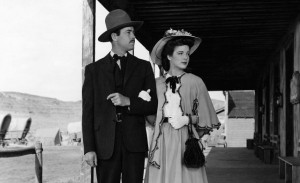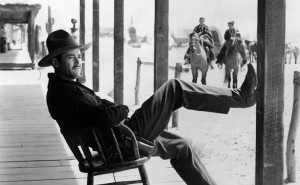STUDIO: Criterion | DIRECTOR: John Ford | STARS: Henry Fonda, Victor Mature, Linda Darnell, Cathy Downs, Walter Brennan, Tim Holt
RELEASE DATE: 10/14/14 | PRICE: DVD $24.95, Blu-ray $29.95
BONUSES: commentary by critic Joseph McBride, interview with Wyatt Earp expert Andrew C. Eisenberg, video essay by Ford scholar Tag Gallagher, comparison of the two versions of the film by Robert Gitt, silent short “Bandit’s Wager,” TV news stories about Tombstone and Monument Valley, “Lux Radio Theater” adaptation of the film
SPECS: NR | 97 min. | Western | 1:33 fullscreen | monaural
Film buffs now have an embarrassment of riches, what with all of the variant versions of classic movies available on disc. This two-DVD package provides a perfect example, as it contains both the familiar 97-minute version of My Darling Clementine (1946), long thought of as one of John Ford’s (Drums Along the Mohawk) utterly perfect Westerns, as well as a 103-minute “pre-release” edition of the film that is slightly longer and contains a number of scenes that are presented as Ford originally intended, before producer Darryl F. Zanuck altered or edited them out entirely.
Thus, the purchasers of this set can choose to watch either version of the film or both with or without an incredibly informative 41-minute featurette that explains the many differences between the two versions. If you’re completely new to the film, the 97-minute version is still a classic and has been beautifully restored. However, the pre-release version — which contains specks of dirt on the image, a welcome reminder that one is watching a film — is really the version to watch, since it contains less of Zanuck’s corniness and more of Ford’s beautiful moments of silence and darkness.
The storyline revolves around the oft-told tale of Wyatt Earp (Henry Fonda, Once Upon a Time in the West), Doc Holliday (Victor Mature, Samson and Delilah) and their showdown at the O.K. Corral with the Clanton family. Ford’s version of the tale, which is almost entirely fictional, includes subplots involving Earp’s mission to make the Clantons pay for the murder of his brother and the arrival of Doc Holliday’s former love, conveniently named Clementine (Cathy Downs).
The film is filled with iconic imagery and admirable mythmaking on the part of Ford and his scripters. Most of the picture qualifies as pure melodrama, with the majority of the running time devoted to issues of romance and family (the showdown with the Clantons occupies only the last 25 minutes of the longer pre-release version). Most impressive are the dark visuals, which not only find the Clantons in shadowed environments but also our conflicted heroes.
In the featurette examining the difference between the two versions, preservationist Robert Gitt notes that Zanuck first removed 30 minutes of footage then had new sequences shot by director Lloyd Bacon before the pre-release version was screened in the summer of 1946.
What Zanuck removed from the preview version were a number of shots that were present to add atmosphere; he also added a musical score to sequences that were silent. One of the biggest differences was the addition of an insert into the final sequence in which Earp kisses Clementine’s cheek. Zanuck, in other words, was intent on spelling out a number of things that Ford left unseen.
Gitt also takes care to note one “fake” shot that Zanuck inserted into the pre-release version (a repetition of a later image of a stagecoach arriving) because it compensated for missing footage that would explain why two characters had moved to another location. Gitt also maintains that Zanuck’s edits improved the film.
Ford himself called Zanuck a “genius” editor because of his work tightening The Grapes of Wrath and How Green Was My Valley. It’s admittedly hard to see how this is so, because so many of the additions are so damned corny, but the experts heard from in this package never condemn Zanuck’s radical overhaul of the movie.
Ford biographer Joseph McBride outlines the situation in his audio commentary track, repeating the compliments that Ford and Zanuck heaped on each other. McBride’s singling out of the best moments in Ford’s work — the ones without dialogue, which are present to set a mood — would tend to, once again, diminish Zanuck’s treacly additions to Clementine.
The package’s best bonus is supplied by Ford scholar Tag Gallagher, who assembled an 18-minute visual essay contextualizing the film. Gallagher emphasizes its dark tone, which he ascribes to the fact that WWII changed Ford — after having witnessed real atrocities, he could no longer glamorize violence.
In addition to offering a fascinating dissection of Ford’s visual style, Gallagher discusses the fact that Ford knew the real Wyatt Earp, who made up the bulk of the stories he told about his days in the Wild West. Ford and his scripter thus felt free to fabricate an almost entirely fictional story about the showdown at the O.K. Corral for the film.
Gallagher’s visual essay is so engrossing that it could easily have run double or triple the length. Another expert who gently punctures the myths in Clementine, while still proclaiming it the best movie about Wyatt Earp ever made, is Earp expert Andrew C. Eisenberg.
Eisenberg declares that Earp’s days as a lawman were a brief part of his life — he was primarily a professional card dealer and gambler. Eisenberg’s other major revelation involves the fact that the Clantons had maintained a friendly relationship with Earp before the eventual showdown (which occurred in real life outside of the O.K. Corral). The showdown wasn’t a battle of good against evil as it’s been depicted; instead it was a dispute between “police officers [the Earps] and their disaffected informants [the Clantons].”
The last great revelation Eisenberg offers about Earp is that there was a real-life epilogue to the showdown that Ford and most other filmmakers — except Lawrence Kasdan, in the endless 1994 epic Wyatt Earp — chose to ignore. The year after the showdown, friends of the Clantons killed Earp’s brother Morgan. Earp assembled a posse and hunted the men down, killing them in cold blood. This story runs counter to the Hollywood image of Earp as a heroic gunman, started in Allan Dwan’s Frontier Marshal (1939) and perpetuated in the Kasdan film and Tombstone (1993).
After watching the pre-release version included on this DVD and the many featurettes that analyze the film, one comes to the inevitable conclusion that, while Ford may have chosen to depict a fictionalized version of events, he wound up creating one of the most poetic Westerns ever made.
|
Buy or Rent My Darling Clementine
|
|||
|---|---|---|---|
DVD |
 |
 DVD | Blu-ray DVD | Blu-ray |
|


Leave a Reply